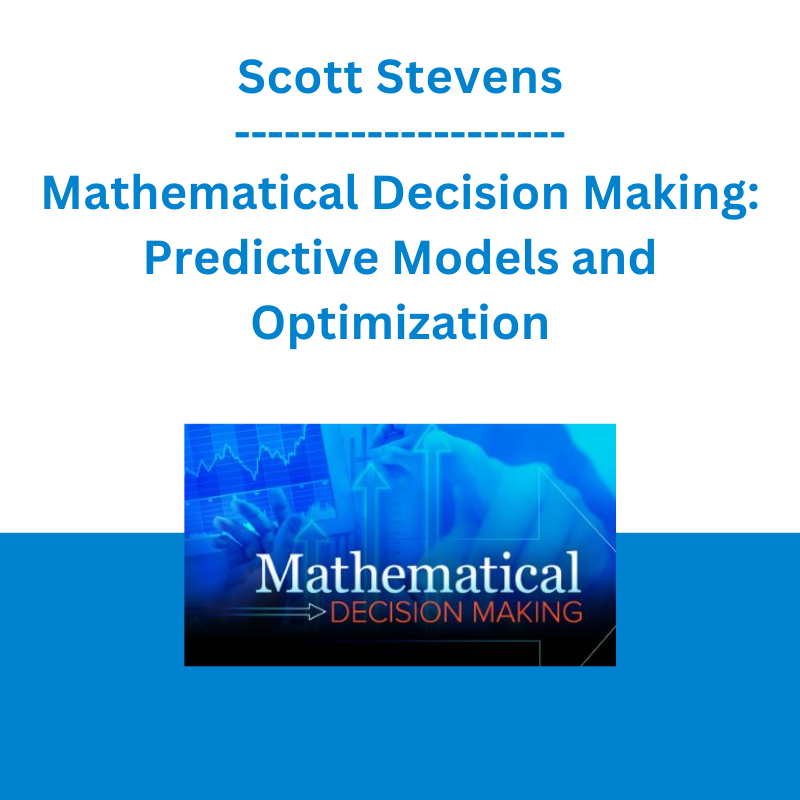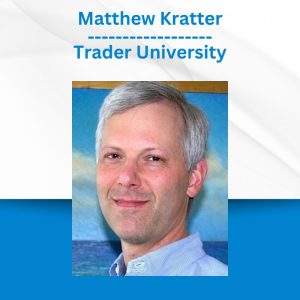*** Proof of Product ***

Exploring the Essential Features of “Scott Stevens – Mathematical Decision Making: Predictive Models and Optimization”
Mathematical Decision Making: Predictive Models and Optimization
Handle complex decisions with ease and confidence using powerful mathematical concept in this course taught by an award-winning mathematician.
LESSON
Trailer
01:The Operations Research Superhighway
Survey the extraordinary range of applications for operations research and predictive analytics. Professor Stevens defines these fields, previews the mathematical techniques that underlie them, and charts their history, from World War II defense research to their rapid growth in the computer era.
33 min
02:Forecasting with Simple Linear Regression
Linear regression is a powerful method for describing connections between related quantities. Analyze several problems using linear regression. For example, predict the waiting time for an eruption of the Old Faithful geyser based on how long the previous eruption lasted….
32 min
03:Nonlinear Trends and Multiple Regression
Explore more complex linear regression problems, which involve nonlinear functions and/or multiple inputs. Many real-life situations require these approaches, called transformation of variables and multiple linear regression. Learn how to envision the data graphically, and witness the ease with which spreadsheets solve these problems….
32 min
04:Time Series Forecasting
Time series forecasting is a valuable tool when there’s little data on what drives a process. Using the example of U.S. housing starts, learn how to glean information from historical figures, taking into account both long-term trends and seasonal fluctuations to create a forecast and assess its reliability….
32 min
05:Data Mining-Exploration and Prediction
Plunge into the fast-growing field of data mining, which exploits computational power and innovative algorithms to analyze the ever-increasing deluge of data. Focus on classification and prediction, seeing how classification trees can help solve the problem of building a filter that predicts spam email messages….
32 min
06:Data Mining for Affinity and Clustering
Delve deeper into data mining by exploring affinity analysis, or “what goes with what.” One approach uses association rules to discover relevant connections between variables, while another employs clustering. For example, Pandora Radio uses these tools to make music recommendations based on a listener’s song preferences….
30 min
07:Optimization-Goals, Decisions, and Constraints
Get the big picture on optimization, which is the focus of the next section of the course. Optimization seeks the best possible answer to a given problem. Learn how to model an optimization problem by asking four key questions. Then trace the steps in an example from the airline industry. …
29 min
08:Linear Programming and Optimal Network Flow
Continue your study of optimization problems by looking at solutions that use linear programming-an approach of exceptional power, speed, and simplicity. See how linear programming showed Union Pacific a cost-saving way to distribute railroad cars to locations throughout the country….
32 min
09:Scheduling and Multiperiod Planning
Investigate multiperiod planning problems. You will apply the tools from previous lectures to schedule activities and control inventory. You will also map out an investment plan that gives you the money you need, when you need it….
29 min
10:Visualizing Solutions to Linear Programs
Mathematical intuition can be a powerful tool for solving mathematical problems. See how the answer almost jumps out at you when you apply a graphical method to certain types of optimization problems. Professor Stevens walks you through a real-life example involving personal financial investments-and spaghetti….
31 min
11:Solving Linear Programs in a Spreadsheet
Learn how to solve a linear program using the famous simplex algorithm, developed by George Dantzig. Follow this easy, step-by-step approach that will allow you to use a spreadsheet, such as Calc or Excel, to find the optimal solution to virtually any linear program that has one. Watch how fast you get results!…
31 min
12:Sensitivity Analysis-Trust the Answer?
How much can you change a parameter in a problem before you affect the optimal solution? How do you forecast the tipping point at which dramatic changes occur? Sensitivity analysis will do the trick. Investigate the application of this valuable tool to linear programs….
31 min
13:Integer Programming-All or Nothing
Many problems contain variables that must be integers-for example, the number of units of a product or the number of production plants. Explore the special challenges presented by integer programs. Solve examples using the graphical method, then see how to find solutions with a spreadsheet….
31 min
14:Where Is the Efficiency Frontier?
Rating the efficiency of an operation is difficult if multiple inputs and outputs are involved. This often happens when trying to evaluate productivity among non-profits or government programs. Learn to use a popular technique that makes such comparisons simple, thanks to data envelopment analysis….
32 min
15:Programs with Multiple Goals
How do you evaluate the quality of a solution based on more than a single objective? Focus on three approaches: the weighted average, soft constraints combined with penalties, and prioritizing goals. Evaluate these in terms of NBC’s difficulty in setting television advertising schedules, due to multiple objectives….
30 min
16:Optimization in a Nonlinear Landscape
Review the lessons of linear programming, which you have been studying since Lecture 8. Then venture into the world of nonlinear programming. Professor Stevens orients you to this fascinating realm by demonstrating techniques that build your mathematical intuition for solving nonlinear problems….
31 min
17:Nonlinear Models-Best Location, Best Pricing
Roll up your sleeves and tackle two practical problems in nonlinear programming: pick a location for a hub in an airline flight network, and price a retail product for maximum sales. In the latter case, you learn to model what makes Costco such a runaway success….
33 min
18:Randomness, Probability, and Expectation
Probability allows you to evaluate situations where only partial control is possible-such as investment opportunities, public relations problems, and waiting lines. Hone your skills in elementary probability with simple challenges, including a game called “Cat or No Cat.”…
32 min
19:Decision Trees-Which Scenario Is Best?
See how decision trees and probability analysis can lead to optimal decisions in situations that seem bewilderingly uncertain. Professor Stevens focuses on a potential public relations disaster faced by executives at Gerber Products and how they used a decision tree to chart a successful strategy….
31 min
20:Bayesian Analysis of New Information
According to Bayes’s theorem, the chance that something is true changes as new and better information becomes available. Trace the use of this principle in the search for wreckage from Air France flight 447, and learn how itthis simple but powerful idea serves as a corrective to bad decision making in many spheres….
31 min
21:Markov Models-How a Random Walk Evolves
Peer into the future with Markov analysis, which studies random systems to predict possible future outcomes. Apply this technique to the downed plane example from the previous lecture, and then see how Markov analysis helped a German direct-marketing firm avoid financial ruin….
31 min
22:Queuing-Why Waiting Lines Work or Fail
Extend your use of Markov analysis to waiting lines, or queues. Discover how a random arrival process is analogous to the sound of popcorn popping. Then probe the dramatic decrease in waiting times that can result from relatively minor adjustments in workforce or equipment….
30 min
23:Monte Carlo Simulation for a Better Job Bid
Graduate to one of the most versatile and widely used techniques in operations research: simulation, which models the intricate interplay of variables in complicated situations. Focus on a competitive bid for a building project and how simulation can come up with a winning strategy….
30 min
24:Stochastic Optimization and Risk
Bring your entire toolkit to bear on the case history from Lecture 23, using stochastic optimization to take the full measure of your competitors for the building project. With this closing problem, you’ll see how combining predictive analytics and optimization can help you stay one step ahead of the competition….
32 min
DETAILS
Overview
Researchers have perfected mathematical techniques for predicting the best possible outcomes when faced with conflicting options. Now, all you need is a computer and spreadsheet program to harness the power of these methods for solving practical problems. Discover the endless ways in which applying quantitative methods helps problem solvers like you make better decisions in business, research, government, and beyond.
About
Scott P. Stevens
If you keep your eyes and mind open, you’re going to find a lot of other places that our ideas apply.
Dr. Scott P. Stevens is Professor of Computer Information Systems and Management Science at James Madison University in Harrisonburg, Virginia, where he has taught since 1984. Professor Stevens holds a Ph.D. in Mathematics from The Pennsylvania State University, where he received B.S. degrees in both Mathematics and Physics and graduated first in his class in the College of Science. Honored many times over for his remarkable abilities in the classroom, Professor Stevens has been a recipient of the Carl Harter Award, his university’s highest teaching award; been named the outstanding graduate teacher in JMU’s M.B.A. program; and has on five occasions been selected by students as the outstanding teacher in JMU’s undergraduate business program, the first teacher to be so honored. A frequent consultant in the business arena, Professor Stevens has been published in a broad variety of academic and professional journals, writing or collaborating on subjects as varied as neural network prediction of survival in blunt-injured trauma patients; the effect of private school competition on public schools; standards of ethical computer usage in different countries; automatic data collection in business; and optimization of the purchase, transportation, and deliverability of natural gas from the Gulf of Mexico.
REVIEWS
LL1965
Exceptionally gifted teacher
Where were you, Professor Stevens, when I was learning this in business school?
The instructor of this course is exceptional in that he is able to make the most abstract concepts easy to understand with real, relatable real life scenarios and expertly executed animated illustrations. His humorous and engaging personal style also add significantly to the performative aspect of the presentations. The result was that I found myself mesmerized and could not wait to watch the next episode. Now, how rare is it to find a math student saying that she can’t wait for the next lecture! I’m impressed!
Railroadmike
PA
Excellent content
I am very happy with the purchase. the only criticism that I have is that the professor speaks too fast for me.
David Tavadian
London U.K.
Encompassing and relevant
The combination of mathematics and programming/coding is the future. We need many more courese that teach this combination. Professor Stevens did an excellent job in trying to exaplain complex concepts in simple terms.
Please see the full list of alternative group-buy courses available here: https://lunacourse.com/shop/









